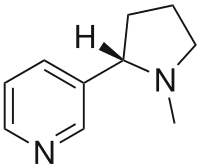
Photo from wikipedia
Perampanel (PER), a noncompetitive α-amino-3-hydroxy-5-methyl-4-isoxazole propionate receptor antagonist, clinically used for seizure control, has been reported to exert neuroprotective effects in experimental models of neurodegenerative diseases. However, few studies have… Click to show full abstract
Perampanel (PER), a noncompetitive α-amino-3-hydroxy-5-methyl-4-isoxazole propionate receptor antagonist, clinically used for seizure control, has been reported to exert neuroprotective effects in experimental models of neurodegenerative diseases. However, few studies have investigated the therapeutic effects of PER in brain injury including stroke. Our aim was to investigate the neuroprotective potential of PER using a rat transient middle cerebral artery occlusion (MCAO) model. Sprague-Dawley rats underwent 90-min MCAO followed by intraperitoneal PER administration at a dose of 1.5 mg/kg. Infarct volumes, neurological deficits, and immunological analyses were performed at 7 days after MCAO. PER significantly reduced infarct volumes (p < 0.05) and improved motor function (p < 0.05) compared with vehicle. Immunological analysis showed that PER significantly inhibited microglial activation, pro-inflammatory cytokine expression, and oxidative stress compared with vehicle. Moreover, PER suppressed neurodegeneration in the cortical ischemic boundary zone, via downregulation of Bcl-2-associated x and upregulation of Bcl-extra-large with Akt activation. In addition, post-stroke secondary neuronal damage and cognitive impairments, using the Y-maze test, were assessed 30 days after MCAO. PER significantly improved spatial working memory, which was accompanied by hippocampal CA1 neuronal loss and cortical thinning, compared with vehicle. These results indicate that PER attenuates infarct volumes and motor function deficits possibly through its anti-inflammatory, antioxidant, and anti-apoptotic activities, mediated via activation of phosphatidylinositol 3-kinase (PI3K)/Akt pathways in the acute ischemic phase, and further ameliorates post-stroke cognitive impairments via the suppression of secondary neuronal damage in the chronic ischemic phase.
Journal Title: Neuroscience
Year Published: 2018
Link to full text (if available)
Share on Social Media: Sign Up to like & get
recommendations!